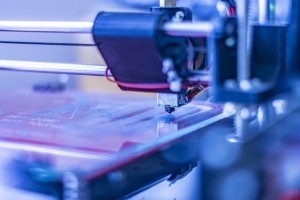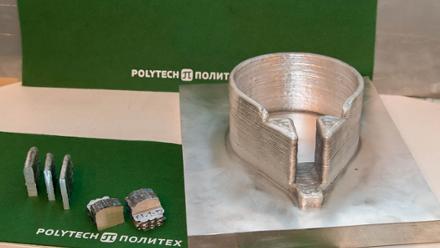2D inks and additive manufacturing
Functional materials using 2D reactive inks could be a game changer for additive manufacturing. Dr Kate Black of the University of Liverpool, UK, and Co-Founder of Meta Additive explains more.

Inkjet printing is an automated, non-contact and eco-friendly additive manufacturing technique. First developed in the early 1950s to produce documents by printing coloured inks, it wasn’t until the 1990s that inkjet printing was used to print functional materials. Over recent years, its exploitation has been shown to shorten product development, reduce costs and enable a more rapid time-to-market for improved electronic devices.
In particular, inkjet printing offers an attractive additive manufacturing method for depositing metal interconnects in electronic systems and enables a low-cost route to manufacture for many devices such as photovoltaic cells, sensors and batteries. Despite the numerous advantages, all the conducting polymers, nanoparticle solutions and dispersant inks commonly used to fabricate conductive elements have associated drawbacks.
At the present time, virtually all metal, inkjet-deposited films require post-deposition heat treatment to achieve an optimum level of electrical conductivity, as their growth mechanism necessitates coalescence of discrete nanoparticles. The need for subsequent heat treatment limits the range of materials that can be used, thereby limiting the current application areas of inkjet printed materials to only those that can withstand high temperatures. Also, within manufacturing plants, the equipment used for heat treatment, such as sintering ovens, can be expensive and often can have large footprints, thereby potentially adding a significant additional financial burden to the overall cost of production.
Meanwhile, silver-copper electrodes for organic field effect transistor applications have been investigated by employing silver-copper nanoparticle-based inks. However, studies have found that the copper oxidises due to the large surface area of the nanoparticles, and when the particle size is increased to inhibit oxidation, the injector head becomes blocked, which is detrimental to the printed metal track formation. Typically, the use of nanoparticle solutions also results in low-conductivity circuits, leading to poor performance due to ohmic losses. These issues are fundamental attributes of nanoparticle solution-based inks.
Another class of inks, known as metal-organic decomposition (MOD) inks, have been shown to prevent nozzle clogging as the metals are in solutions and do not require colloidal stabilisers. MOD inks are used by several leading research groups to deposit metal interconnects using inkjet technology. However, MOD inks require numerous printing passes to obtain adequate conductivity along with high post-processing temperatures.
Therefore, to use inkjet printing for additive manufacturing of functional materials in printed electronics and wider applications, we need to broaden the palette of available materials, understand printed materials interfaces, and develop simultaneous printing and processing of multifunctional materials.
A new palette
A sinter-free manufacturing method for inkjet processing of metal and ceramic films represents an opportunity to create a transformative step-change in the field of additive manufacturing. A new class of ink formulations, known as reactive organometallic (ROM) inks, created at the University of Liverpool, are solution-based containing no particulates, meaning that, unlike nanoparticle and MOD inks, they do not require post-deposition treatments such as sintering (typically ≥300°C) to convert the deposits into a continuous conducting metallic film.

They work by exploiting surface chemistry processes and materials and were originally developed for atomic layer deposition (ALD). The ROM inks came out of previous work the team had carried out with liquid injection ALD, whereby organometallics are dissolved in inert solvents such as toluene. These solutions are then tailored so that their rheology is suitable for jetting out of an inkjet head. In the context of inkjet injection, we can tailor the substrate temperature and the enthalpy of reaction of the organometallic precursor with a co-reducing agent, such as an alcohol or hydrazine, to ensure a surface-driven process rather than a homogeneous one. Through this approach, the organometallic decomposition rate can be tailored to ensure coalescence of crystalline films, which does not require subsequent sintering to make them electrically conductive.
As they are sinter-free, ROM inks offer lower thermal budgets, shorter processing times and improved physical properties when compared with conventional metallic inks.
There is also scope to enhance the concept of ‘reactive inkjet printing’, whereby chemical reduction, rather than decomposition, occurs in the developing film at the substrate.
Unlike MOD inks, ROM formulations do not decompose. Instead, chemical reduction occurs on the printed surface by employing adducts and a reducing agent in the ink formulation, which provides greater purity of the printed material. ROM inks also allow material control at the molecular level, so complex alloys and graded stoichiometries can be printed. Finally, ROM inks can be combined with nanoparticles to produce a hybrid ink for 2D and 3D applications.
From low temperatures to 3D Initially, the project has involved using ROM inks for silver to print collector grids for solar cells. This has since moved on to include copper, aluminium, palladium and a variety of metal oxides such as titanium dioxide. These inks are printed either at room temperature or using a mild heating temperature of no greater than 100°C. The low processing temperature means ROM inks can be printed on thermally-sensitive substrates, such as plastics and paper, thereby expanding their application use.
The team at Liverpool are also using ROM inks in combination with particles and powder beds to print 3D structures, with the capability of embedding sensors and electronics within 3D-printed components.
Sensing change
Growing commercial demand for smaller and cheaper sensors over the past few years has meant that the production of sensors on flexible substrates has become increasingly attractive for manufacturers. To be fit-for-purpose, the conductive tracks must be robust, adhere well to plastic substrates, such as polyethylene terephthalate, polyethylene naphthalate or polycarbonate, resist the acid electrolytes used in electrochemical sensors, and be compatible with subsequent production processes.Working with a sensor technology company, the research group at the University of Liverpool, UK, has investigated how inkjet printing can be used to manufacture industrial electrochemical carbon dioxide and nitrogen dioxide gas sensors using its reactive organometallic (ROM) ink formulations for silver, platinum, ruthenium and carbon nanotubes, before additively manufacturing and characterising the interfaces of the printed components.
The team has developed novel ink formulations to provide surface driven reactions at low temperatures, offering the opportunity to deposit multiple layers of materials with controlled compositions. This is important as control of the composition and structure of the electrodes in electrochemical sensors are critical factors for performance and cost.
Adventures in energy
Through the EPSRC’s Adventures in Energy programme, the team at the University of Liverpool, UK, collaborated with Johnson Matthey Fuel Cells, Arcola Energy and UK Universities in Bath and Cambridge to develop an integrated, anode-less, polymer electrolyte membrane (PEM) technology. The aim is to use hydrogen-rich compounds such as ammonia as direct feed for the PEM fuel cells, overcoming the safety, storage and impurity-related challenges of the current technology.The project has used inkjet printing to manufacture catalytic membranes using Liverpool's reactive organometallic ink formulations for precious metals such as silver and palladium. A multifunctional layer enables in situ production and purification of hydrogen in place of the conventional anode in PEM fuel cells, with a focus on heat integration, water management and long-term stability versus poisoning.








